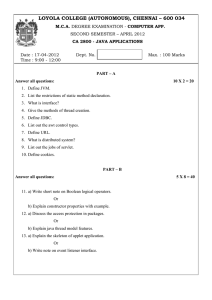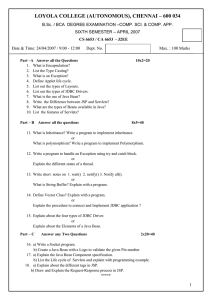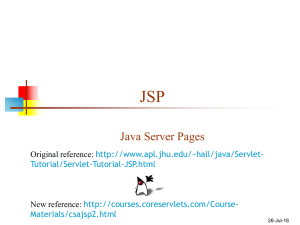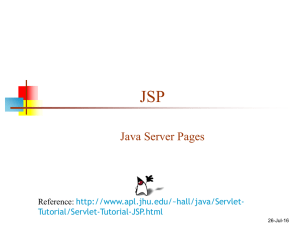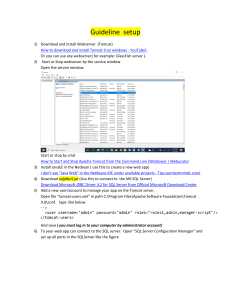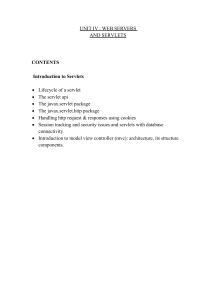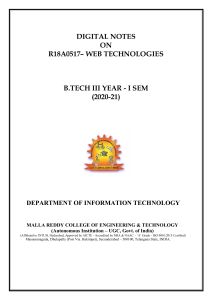An Example Servlet Putting it all together 26-Jul-16
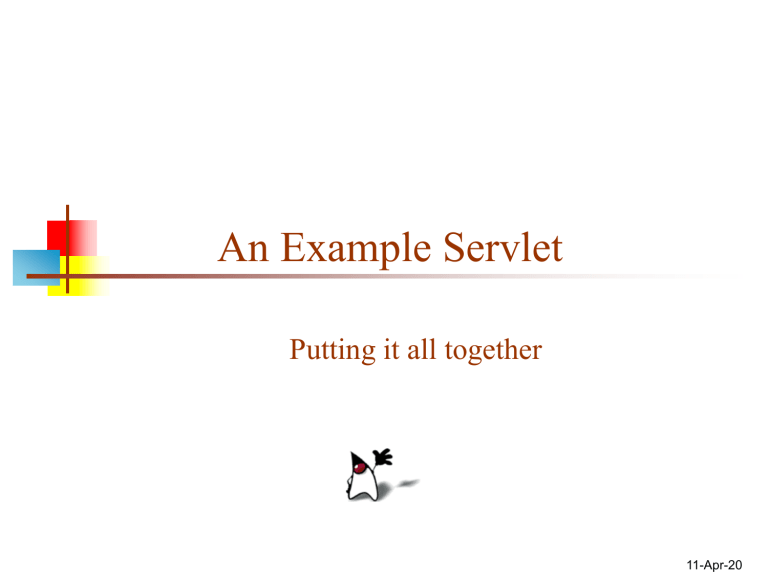
An Example Servlet
Putting it all together
11-Apr-20
Credits
This is the first example in Head
First Servlets & JSP by Brian Basham,
Kathy Sierra, and
Bert Bates
This is an excellent book, and goes into considerably more detail than we will in this course
It starts with an HTML form...
The HTML page, 1
<html>
<head>
<title>Beer Selection</title>
</head>
<body>
<h1 align="center">Beer Selection Page</h1>
...the form (on the next slide)...
</body>
</html>
The HTML page, 2
<form method="POST" action="SelectBeer.do">
Select beer characteristics:<p>
Color:
<select name="color" size="1">
<option>light</option>
<option>amber</option>
<option>brown</option>
<option>dark</option>
</select>
<br>
<br>
<center>
<input type="SUBMIT">
</center>
</form>
The deployment descriptor
The request goes to the server, with the action
<form method="POST" action="SelectBeer.do">
The name
"SelectBeer.do" is not the name of an actual file anywhere; it is a name given to the user
Partly, this is for security; you don’t want the user to have access to the actual file without going through your form
The extension
.do
is just a convention used by this particular book; no extension is necessary
It is up to the deployment descriptor to find the correct servlet to answer this request
The deployment descriptor must be named web.xml
web.xml
1 -- boilerplate
<?xml version="1.0" encoding="ISO-8859-1"?>
<web-app xmlns="http://java.sun.com/xml/ns/j2ee" xmlns:xsi="http://www.w3.org/2001/XMLSchema-instance" xsi:schemaLocation="http://java.sun.com/xml/ns/j2ee/web-app_2_4.xsd" version="2.4">
...important stuff goes here...
</web-app>
web.xml
2 -- actual work
<servlet>
<servlet-name> Ch3 Beer </servlet-name>
<servlet-class> com.example.web.BeerSelect
</servlet-class>
</servlet>
<servlet-mapping>
<servlet-name> Ch3 Beer </servlet-name>
<url-pattern> / SelectBeer.do
</url-pattern>
</servlet-mapping>
BeerSelect.java
1
} package com.example.web; import javax.servlet.*; import javax.servlet.http.*; import java.io.*; import java.util.*; import com.example.model.BeerExpert; // notice this public class BeerSelect extends HttpServlet {
... doPost method goes here. ..
BeerSelect.java
2
public void doPost(HttpServletRequest request,
HttpServletResponse response) throws IOException, ServletException {
String c = request.getParameter("color");
BeerExpert be = new BeerExpert();
List result = be.getBrands(c);
} request.setAttribute("styles", result);
RequestDispatcher view = request.getRequestDispatcher("result.jsp"); view.forward(request, response);
MVC
BeerSelect.java acts as the controller
It delegates the actual work to a model ,
BeerExpert.java
It delegates (forwards) the information to a JSP page that will provide the view
RequestDispatcher view = request.getRequestDispatcher("result.jsp"); view.forward(request, response);
The model class
BeerExpert is the model class; it computes results and adds them to the
HttpServletRequest object
Not the
HttpServletResponse object; that’s the HTML output
It returns, in the usual fashion, to the
BeerSelect class, which will then forward it to the JSP
BeerExpert.java
package com.example.model; import java.util.*; public class BeerExpert {
}
} public List getBrands(String color) {
List brands = new ArrayList(); if (color.equals("amber")) { brands.add("Jack Amber"); brands.add("Red Moose");
} else { brands.add("Jail Pale Ale"); brands.add("Gout Stout");
} return brands;
The JSP file
The JSP file must have the extension
.jsp
It is basically HTML, plus a few JSP directives
It receives the
HttpServletRequest and the
HttpServletResponse objects
The
HttpServletResponse object may have been partially written by the servlet (but it’s a bad idea)
The resultant HTML page goes back to the user
result.jsp
<%@ page import="java.util.*" %>
<html>
<body>
<h1 align="center">Beer Recommendations JSP</h1>
<p>
<%
List styles = (List)request.getAttribute("styles");
Iterator it = styles.iterator(); while (it.hasNext()) { out.print("<br>TRY: " + it.next());
}
%>
</body>
</html>
Directory structure
jakarta-tomcat-5.0.12/
| webapps/ this is http://m174pc4.cis.upenn.edu:8080/
| | beerV1/
| | | form.html
| | | result.jsp
| | | WEB-INF/
| | | | web.xml
| | | | classes/
| | | | | com/
| | | | | | example/
| | | | | | | model/
| | | | | | | | BeerExpert.class
| | | | | | | web/
| | | | | | | | BeerSelect.class
| | | | lib/
| | yourLastName when you ftp, this is where you are
Accessing the class server
Tomcat should be running 24/7 on m174pc4.cis.upenn.edu
To try it, point your browser to: http://m174pc4.cis.upenn.edu:8080/beerV1/form.html
When you ftp to m174pc4
, pwd will tell you that you are in a directory “ / ”, but you are really in a directory
C:\Tomcat\webapps\ yourLastName
This is the top-level directory for your web applications
You should be able to put an HTML file here, say, index.html
, and access it with http://m174pc4.cis.upenn.edu:8080/ yourLastName /index.html
